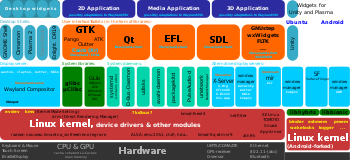D-Bus
| Developer(s) | Red Hat and the community |
|---|---|
| Stable release | 1.8.6[1]
/ July 2, 2014 |
| Repository | |
| Written in | C |
| Operating system | Cross-platform |
| Type | |
| License | GNU General Public License version 2 or later, or Academic Free License 2.1[2] |
| Website | www |
D-Bus is a free and open-source inter-process communication (IPC) system, allowing multiple, concurrently-running computer programs (processes) to communicate with one another.
D-Bus provides the following functionality:
- communication between desktop applications in the same desktop session; to allow integration of the desktop session as a whole, and address issues of the process lifecycle
- communication between the desktop session and the operating system, where the operating system would typically include the kernel and any system daemons or processes
Heavily influenced by the DCOP system used by versions 2 and 3 of KDE, D-Bus has replaced DCOP in the KDE 4 release. An implementation of D-Bus supports most POSIX operating systems, and a port for Windows exists. It is used by Qt 4 and GNOME. In GNOME it has gradually replaced most parts of the earlier Bonobo mechanism. It is also used by Xfce.
D-Bus is developed as part of the freedesktop.org project.
Design
D-Bus is a message-bus system, a medium for interprocess communication. The message bus is built on top of a general one-to-one message passing framework, which any two apps can use to communicate directly with one another (i.e., without going through the message bus daemon).
Most systems implement a privileged system channel, plus a private channel for each logged-in user, so that available information in the D-Bus registry can be restricted. Accordingly, the D-Bus service includes both a system daemon (for events such as "new hardware device added" or "printer queue changed") and a distinct daemon for each user login session (for general inter-process communication needs between applications started by the particular user). Applications communicate with daemons over Unix domain sockets.
As of January 2014[update], there is an ongoing development project called kdbus that aims to replace D-Bus with a kernel-mediated peer-to-peer inter-process communication mechanism. Beside performance improvements, kdbus would have advantages arising from already existing Linux kernel features such as namespaces and auditing.[3][4]
Architecture

dbus-daemon (named ubus in the illustration) is essentially at the core of the modern Linux graphical desktop environment. Binder is the counterpart used on Android.D-Bus has three architectural layers:[5]
- libdbus - a library that allows two applications to connect to each other and exchange messages
- dbus-daemon - a message-bus daemon executable, built on
libdbus, that multiple applications can connect to. The daemon can route messages from one application to zero or more applications, thereby implementing the publish/subscribe paradigm. - wrapper libraries based on particular application frameworks
In 2013 the systemd project rewrote libdbus in an effort to simplify the code, but it turned out to significantly increase the performance of D-Bus as well. In preliminary benchmarks, BMW found that the systemd D-Bus library increased performance by 360%.[6]
Mechanisms
Messages received over a D-Bus connection get routed to a specific object, not to a process. It thus appears to clients as if they are interacting with an object whether or not there actually is an object on the other side.
D-Bus defines a name for each object which looks like (but is not actually) a POSIX filesystem path, e.g., /org/kde/kspread/sheets/3/cells/4/5. D-Bus objects' names are conventionally namespaced to help with independently developing code modules.[7] Namespaces are generally prefixed with the developer's reserved domain name components (e.g. /org/kde).
See also
References
- ^ "Announcing dbus 1.8.6 (security fix release)". 2014-07-02.
- ^ Havoc's Blog July, 2007
- ^ Jake Edge (2013-05-30). "ALS: Linux interprocess communication and kdbus". LWN.net. Retrieved 2014-04-11.
- ^ Jonathan Corbet (2014-01-13). "The unveiling of kdbus". LWN.net. Retrieved 2014-04-11.
- ^ "Get on the D-BUS". Linux Journal. Retrieved 2008-01-23.
- ^ "ALS: Linux inter-process communication and kdbus". LWN.net. 2013-05-30. Retrieved 2013-11-13.
- ^ "D-Bus Tutorial".
External links
- D-Bus home page at Freedesktop.org
- Introduction to D-Bus on the Freedesktop.org wiki
{{IPC athlete}} template missing ID and not present in Wikidata.

